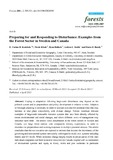| dc.contributor.author | Keskitalo, E. Carina H. | |
| dc.contributor.author | Klenk, Nicole | |
| dc.contributor.author | Bullock, Ryan | |
| dc.contributor.author | Smith, Andrea L. | |
| dc.contributor.author | Bazely, Dawn R. | |
| dc.date.accessioned | 2018-06-13T19:17:32Z | |
| dc.date.available | 2018-06-13T19:17:32Z | |
| dc.date.issued | 2011 | |
| dc.identifier.citation | Keskitalo, E. C. H., Klenk, N., Bullock, R., Smith. A. L., and D. R. Bazley. "Preparing for and responding to disturbance: Examples from the forest sector in Sweden and Canada." Forests 2(2) (2011): 505-524. doi:10.3390/f2020505. | en_US |
| dc.identifier.issn | 1999-4907 | |
| dc.identifier.uri | http://hdl.handle.net/10680/1498 | |
| dc.description.abstract | Coping or adaptation following large-scale disturbance may depend on the political system and its preparedness and policy development in relation to risks. Adaptive or foresight planning is necessary in order to account and plan for potential risks that may increase or take place concurrently with climate change. Forests constitute relevant examples of large-scale renewable resource systems that have been directly affected by recent environmental and social changes, and where different levels of management may
influence each other. This article views disturbances in the forest sectors of Sweden and
Canada, two large forest nations with comparable forestry experiences, in order to
elucidate the preparedness and existing responses to multiple potential stresses. The article concludes that the two countries are exposed to stresses that indicate the importance of the governing and institutional system particularly with regard to multi-level systems including federal and EU levels. While economic change largely results in privatization of risk onto individual companies and their economic resources (in Canada coupled with a contestation of institutional systems and equity in these), storm and pest outbreaks in particular challenge institutional capacities at administrative levels, within the context provided by governance and tenure systems. | en_US |
| dc.description.sponsorship | In Sweden, funding from the research agency FORMAS, the MISTRA Arctic Futures programme, and the Future Forests programme (funded by research agency MISTRA, the forest industries, Umeå University and the Swedish University of Agricultural Sciences) as well as from the EU for data collection is acknowledged. Ryan Bullock acknowledges funding provided by the Social Sciences and Humanities Research Council and by the Mistra Arctic Futures programme for preparing this paper. | en_US |
| dc.description.uri | https://www.mdpi.com/1999-4907/2/2/505 | |
| dc.language.iso | en | en_US |
| dc.publisher | Forests | en_US |
| dc.rights | info:eu-repo/semantics/openAccess | |
| dc.subject | adaptation | en_US |
| dc.subject | adaptive capacity | en_US |
| dc.subject | Sweden | en_US |
| dc.subject | Canada | en_US |
| dc.subject | forestry | en_US |
| dc.subject | economic crisis | en_US |
| dc.subject | forest pests | en_US |
| dc.subject | storms | en_US |
| dc.title | Preparing for and Responding to Disturbance: Examples from the Forest Sector in Sweden and Canada | en_US |
| dc.type | Article | en_US |
| dc.identifier.doi | 10.3390/f202050 | |

